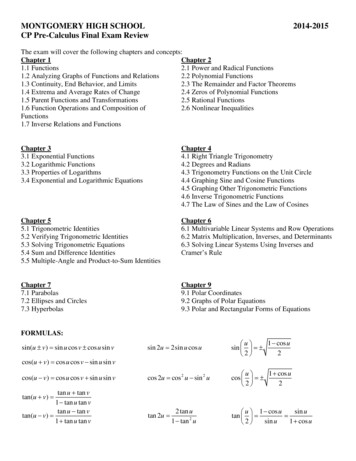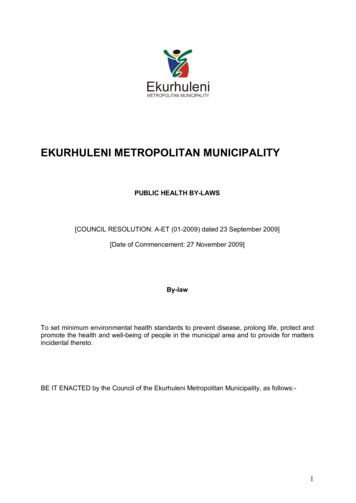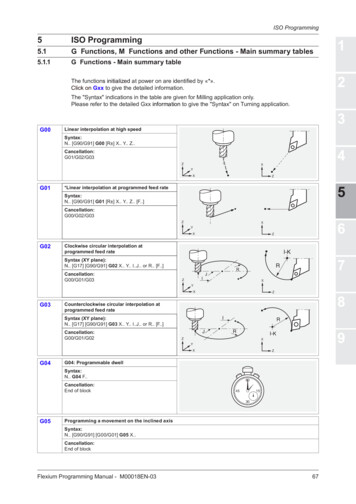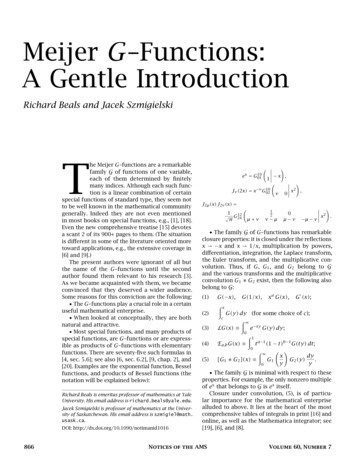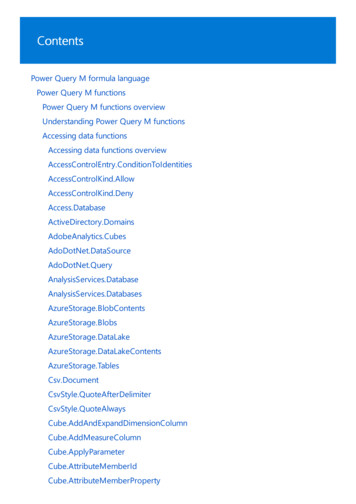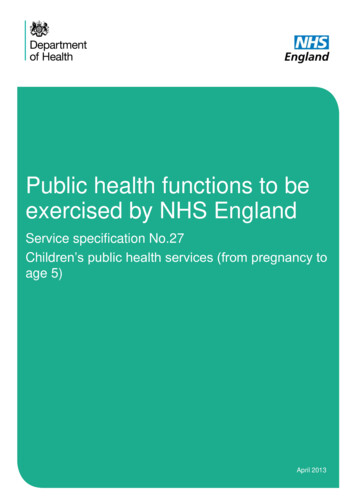
Transcription
Public health functions to beexercised by NHS EnglandService specification No.27Children’s public health services (from pregnancy toage 5)April 2013
You may re-use the text of this document (not including logos) free of charge in any format ormedium, under the terms of the Open Government Licence. To view this licence, nt-licence/ Crown copyrightPublished to gov.uk, in PDF format only.www.gov.uk/dh2
Public health functions to beexercised by NHS EnglandService specification No.27Children’s public health services (from pregnancy toage 5)Prepared by Starting Well - Social Care, Local Government & Care Partnerships DirectorateDepartment of Health3
ContentsContents. 4Service specification No.27 . 6Introduction . 71Background and context . 7The Universal Offer – the Healthy Child Programme and Health Visiting . 7The Targeted Offer – The Family Nurse Partnership Programme . 8Commissioning responsibilities . 92Purpose of the service specification . 9Scope, aims, objectives and outcomes . 113Public health for children under 5 service scope . 114Aims and objectives . 115Health Outcomes. 126Population needs. 137Principles . 14Service delivery . 158Service description for the universal elements of the HCP . 159The care pathway for the universal elements of the HCP . 2010Service description and care pathway for the targeted element of the HCP – the FamilyNurse Partnership programme . 23FNP licence and national leadership. 23Roles. 23FNP target population . 24Aims . 24Service description. 24Expectation of providers . 25Service model . 26Recruitment Pathway . 26Care Pathway . 27Discharge Criteria and Planning . 2811Service Integration . 2912Workforce . 29Health visitors . 29FNP Teams . 3113Locations of Service delivery . 324
Public health functions to be exercised by NHS England14Materials, tools, equipment and other technical requirements . 3215Record keeping, data collection systems and information sharing . 3316Resources and efficiencies . 3417Contribution of NHS CB in commissioning public health services for children under 5 3418National service standards and guidance . 35References. 415
Service specification No.27This is a service specification within Part C of the agreement ‘Publichealth functions to be exercised by the NHS Commissioning Board’dated November 2012 and amended by variation dated April 2013 (the‘2013-14 agreement’). This service specification thereby comes intoeffect and supersedes service specification No.27 dated November2012.The 2013-14 agreement is made between the Secretary of State for Health and the NationalHealth Service Commissioning Board (“NHS CB” or “NHS England”) under section 7A of theNational Health Service Act 2006 (“the 2006 Act”) as amended by the Health and Social CareAct 2012. The 2013-14 agreement may refer interchangeably to NHS CB or NHS England.This service specification is to be applied by the NHS CB in accordance with the 2013-14agreement. An update to this service specification may take effect on an agreed date as avariation made in accordance with the 2013-14 agreement.This service specification is not intended to replicate, duplicate or supersede any otherlegislative provisions that may apply.The 2013-14 agreement including all service specifications within Part C is available atwww.gov.uk (search for “commissioning public health”).6
Public health functions to be exercised by NHS EnglandIntroduction1 Background and context1.1Giving every child the best start in life is crucial to reducing health inequalitiesacross the life course. The foundations for virtually every aspect of humandevelopment – physical, intellectual and emotional – are laid in earlychildhood. What happens during these early years (starting in the womb) haslifelong effects on many aspects of health and well-being, educationalachievement and economic status.1 Universal and specialist public healthservices for children are important in promoting the health and wellbeing of allchildren and reducing inequalities through targeted intervention for vulnerableand disadvantaged children and families. Successive reviews havedemonstrated the economic and social value of prevention and earlyintervention programmes in pregnancy and the early years.2,3,4,5The Universal Offer – the Healthy Child Programme and Health Visiting1.2The Healthy Child Programme (HCP) is the universal clinical and public healthprogramme for children and families from pregnancy to 19 years of age. TheHCP, led by health visitors and their teams, offers every child a schedule ofhealth and development reviews, screening tests, immunisations, healthpromotion guidance and support for parents tailored to their needs, withadditional support when needed and at key times. There is strong evidencesupporting delivery of all aspects of the HCP, which is based on Health for AllChildren, 6 the recommendations of the National Screening Committee,guidance from the National Institute of Health and Clinical Excellence (NICE)and a review of health-led parenting programmes by the University ofWarwick.71.3The Government has committed to improving the health outcomes forchildren, families and their communities by increasing the number of full timeequivalent (FTE) health visitors by 4,200 and implementing an expanded,rejuvenated and strengthened health visiting service by April 2015. TheHealth Visitor Implementation Plan 2011-15 – ‘A Call to Action’, published inFebruary 2011, sets out how this extra capacity will contribute to improvedpublic health outcomes and better personalised care for all families withchildren under 5. Health visitors, working closely with the NHS, GPs, localgovernment, etc. will provide parents with critical health and developmentadvice, and connect families to the array of health and wider communityresources that help them to give their children the best start in life.7
1.4The Implementation Plan clearly set out what all families can expect from theirlocal health visiting service:Health visitors will work to develop and make sure families know about arange of services including services communities can provide forthemselves.A universal service from health visitors and their teams, providing theHealthy Child Programme to ensure a healthy start for children andfamily, support for parents and access to a range of communityservices/resources.A rapid response from the health visitor team when parents need specificexpert help, for example with postnatal depression, a sleepless baby,weaning or answering any concerns about parenting.On-going support from the team, plus a range of local services workingtogether and with families, to deal with more complex issues over aperiod of time. These include services provided by Sure Start Children’sCentres, other community providers including charities and, whereappropriate, the Family Nurse Partnership.The Targeted Offer – The Family Nurse Partnership Programme1.5The Family Nurse Partnership programme (FNP) is an evidence-based,preventive programme for vulnerable first time young mothers. It is importantto note that FNP is a licensed programme and therefore has a well-definedand detailed service model, which must be adhered to. Structured homevisits, delivered by specially trained family nurses, are offered from earlypregnancy until the child is two. Participation in the FNP programme isvoluntary. When a mother joins the FNP programme, the HCP is delivered bythe family nurse instead of by health visitors. The family nurse plays animportant role in any necessary safeguarding arrangements alongsidestatutory and other partners to ensure children are protected.1.6FNP has a strong body of research evidence developed over 30 years in theUSA with evidence reviews consistently identifying it as the most effectivepreventive early childhood programme for improving the health anddevelopment of vulnerable young mothers and their children. FNP is the UKreplication of the Nurse Family Partnership Programme, developed byProfessor David Olds and colleagues in the USA. At the University ofColorado, three large-scale randomised control trials of the programme haveshown a range of benefits for children and mothers over the short, mediumand long-term.8 FNP has been tested in England since 2007; an independentevaluation of the first 10 pilot sites showed FNP could be implemented well inEngland, in accordance with the programme model and in the context of theNHS and that the potential for positive outcomes was good. A large-scale8
Public health functions to be exercised by NHS Englandrandomised control trial to assess the programme’s effectiveness in anEnglish context is underway and due to report initially in early 2014. InEngland, the Parenting Programme Commissioning Toolkit has recentlyevaluated FNP and rated it as having the highest quality of evidence, one ofonly a few programmes rated at this level.91.7The Government has committed to increasing the number of places on theFNP programme to at least 16,000 by April 2015. This does not mean theFNP programme will be available to all those who are eligible. At March2013, this programme covered FNP sites in over 90 upper tier localauthorities, and FNP coverage to the eligible population in these areas varies.Commissioning responsibilities1.8In 2013/14 and 2014/15, the NHS Commissioning Board (NHS CB) willcommission public health services for children under 5 including:The HCP from pregnancy and the first five years of life (working closelywith NHS Services such as maternity services, general practice, earlyyears settings and with children’s social care),Health promotion and prevention interventions by the multiprofessionalteam,The expansion and transformation of health visiting services and to meettraining and workforce trajectories,The Family Nurse Partnership programme, to meet the Government’sexpansion commitment, andChild Health Information Systems (CHIS) the service specification forwhich is set out elsewhere in Part C of this agreement.Responsibility for commissioning these services is expected to transfer tolocal authorities in 2015.1.9Public health services for children aged 5 -19, including public mental healthfor children will be commissioned by local authorities from April 2013. Thiswill include the HCP 5 - 19, health promotion and prevention interventions bythe multiprofessional team and the school nursing service. It will be essentialto work closely with local authorities to ensure a seamless transition at 5years.2 Purpose of the service specification2.1To ensure a consistent and equitable approach across England, a commonnational service specification must be used to govern the provision andmonitoring of public health services for children under 5.9
2.2The purpose of the service specification for public health services for childrenunder 5 is to outline the service and quality indicators expected by the NHSCB and the populations it is responsible for.2.3This service specification is not designed to replicate, duplicate or supersedeany relevant legislation provisions that may apply (e.g. the Health and SocialCare Act 2012). The specification will be reviewed and amended in line withany new guidance.2.4This service specification needs to be read in conjunction with additionalguidance and literature (see Section 18) and importantly ‘The Healthy ChildProgramme: Pregnancy and the first five years of life’(http://www.dh.gov.uk/prod consum dh/groups/dh h 118525.pdf), the Health Visitor ImplementationPlan 2011-15: A Call to Action and supporting health visitor implementationprogramme documents public-health/health-visitors-public-health/), Health visitor employment:from training to practice – a guide for e.aspx), the FNP ManagementManual and the FNP Sub-licensing agreements for Commissioners andProviders given to sites implementing the FNP programme.10
Public health functions to be exercised by NHS EnglandScope, aims, objectives and outcomes3 Public health for children under 5 service scope3.1The service specification covers:The child health surveillance, health promotion and parenting supportelements of the HCP for pregnancy and the first five years of life.The Government’s commitment to increase the number of FTE healthvisitors by 4,200 against a May 2010 baseline of 8,092 and to transformhealth visiting services by April 2015. This will entail increasing workforcenumbers and working closely with Higher Education England to aligngrowth in training capacity in line with annual trajectories produced by theDepartment of Health. It also includes ensuring that the health visitingservice delivers the new service vision encompassing a universal,universal plus, universal partnership plus and community service as setin the Call to Action.The Government’s commitment to increase the number of places on theFNP programme to at least 16,000 by April 2015. This will entailcontinuing to commission, and expand, FNP in areas currently deliveringFNP and increasing the number of areas commissioning the FNPprogramme.National screening programme and immunisation aspects of the HCP aswell as CHIS are separately specified elsewhere in Part C of thisagreement – screening, immunisation, CHIS service specs. However,increased uptake of screening and immunisation programmes is includedas outcomes from these elements of the HCP.3.2Other HCP interdependent NHS services that are out of scope are thosesecondary services that address identified needs including speech andlanguage therapy, infant and parental mental health, NHS safeguardingsupervision and advice, primary care, paediatrics, smoking cessation,contraceptive services and maternity provision (in particular antenataleducation). HCP interdependent non-NHS services that are out of scope butneed to be available are safeguarding, social care, early years education andparenting support.4 Aims and objectives4.1The overarching aim of public health services for children under 5 is to protectand promote the health and well-being of children in the early years.4.2The key objectives are to:11
Improve the health and well-being of children and reduce inequalities inoutcomes as part of an integrated approach to supporting children andfamilies;Ensure a strong focus on prevention, health promotion, earlyidentification of needs and clear packages of support;Ensure delivery of a universal core programme to all children andfamilies;Identify and support those who need additional support and targetedinterventions, for example, parents who need support with their emotionalor mental health and women suffering from postnatal depression;Improve services for children, families and local communities throughexpanding and strengthening health visiting services;Improve pregnancy outcomes, child health and development (includingschool readiness and achievement) and economic self-sufficiency forvulnerable first-time young mothers and their children and familiesthrough the FNP programme;Deliver the increase in the number of health visitors by 4,200 against aMay 2012 baseline of 8,092 and to transform health visiting services byApril 2015; andDeliver the Government’s commitment to increase the number of placeson the FNP programme to at least 16,000 by April 2015.5 Health Outcomes5.1Children’s public health services contribute to the Public Health OutcomesFramework for England 2013 – 2016 (PHOF) which aims “to improve andprotect the nation’s health and wellbeing and to improve the health of thepoorest fastest.”10 Specifically, children’s public health contributes to:Health ImprovementBreastfeeding initiation and prevalence at 6-8 weeks after birth (PHOF2.2)Child development at 2-2½ years (PHOF 2.5)Excess weight in 4 – 5 year olds (PHOF 2.6)Hospital admissions caused by unintentional and deliberate injuries inunder 5s (PHOF 2.7)Access to non-cancer screening programmes (PHOF 2.21 – refscreening service spec)Health ProtectionPopulation vaccination coverage (PHOF 3.3 - ref immunisation servicespec)12
Public health functions to be exercised by NHS EnglandHealthcare public health and preventing premature mortalityInfant mortality (PHOF 4.1)Tooth decay in children aged 5 (PHOF 4.2)Improving the wider determinants of healthSchool readiness (PHOF 1.2)5.2The Children and Young People’s Health Outcomes Strategy will recommendadditional outcome measures that will relate to children’s public health when itis published in autumn 2012 for future consideration.6 Population needs6.1Children’s public health services operate at a population and individual levelwith activities taking place to promote children’s health within communities aswell as with individuals.6.2At a population level, commissioners need a systematic, reliable andconsistent process for assessing needs that provides the basis for configuringservices and allocating resources including delivering the expansion andtransformation of the health visiting service, in line with the Government’scommitment, and ensuring that new health visitors are effectively supportedand deployed.6.3FNP is targeted at first time young mothers, as this is the group shown tobenefit most from the programme, and also whose children are shown to beat high risk of poor developmental outcomes.11,12,13,14,15 The NHS CB shouldagree a commissioning strategy with DH.6.4For the universal elements of the HCP, assessments should be undertaken inpartnership with local agencies as part of the Joint Strategic NeedsAssessment (JSNA) and will need to identify sub-populations in thecommunity (e.g. young parents, travellers, refugees / migrants, black andminority ethnic communities, looked-after children, children with disabilities).PREview (http://www.chimat.org.uk/preview) is a set of planning resourcesthat can help commissioners, managers and professionals to targetpreventive resources, in particular around the Healthy Child Programme,where they are most needed. PREview is based on evidence identifying thefactors in pregnancy and infancy that are associated with outcomes forchildren at five years.6.5For the universal elements of the HCP, at an individual / family level, servicesshould be developed to ensure all those with health needs are identified andthen to determine and personalise the particular provision required.13
7 Principles7.1All individuals will be treated with courtesy, respect and an understanding oftheir needs.7.2All those participating will have adequate information on the benefits and risksof individual elements of children’s public health services to allow parents tomake informed decisions before participating.7.3The target population, for the universal elements of HCP, will have equitableaccess to individual elements of children’s public health services according toneed.7.4For the universal elements of HCP, a flexible approach should be taken toensure services could target specific vulnerable groups or families andworking parents to deliver suitable packages of support.7.5Safeguarding is at the heart of children’s public health. The NHS CB andproviders are required to ensure that services are embedded into localsafeguarding arrangements with health and local authorities.14
Public health functions to be exercised by NHS EnglandService delivery8 Service description for the universal elements of the HCP8.1The universal elements of the HCP will be delivered by a team led by healthvisitors working in way that is most appropriate to local public health needsand across a range of settings and organisations including general practice,maternity services and children’s centres (except where families areaccessing FNP, in which case the FNP nurse – family nurse – will take on thisrole until the child is two years old). As an overview, core elements of theHCP include:Health and development reviews – To assess family strengths, needsand risks; provide parents the opportunity to discuss their concerns andaspirations; assess child growth and social and emotional development;and detect abnormalities.Screening – Screening is an integral part of the universal HCP.Commissioning of national childhood screening programmes is specifiedseparately elsewhere in Part C of this agreement.Immunisations – Immunisations should be offered to all children andtheir parents. General practices and child health record departmentsmaintain a register of children under five years, invite families forimmunisations and maintain a record of any adverse reactions in theCHIS.16 At every contact, members of the HCP team should identify theimmunisations status of the child. Commissioning of childhoodimmunisation programmes is specified separately elsewhere in Part C ofthis agreement.Promotion of social and emotional development – The HCP includesopportunities for parents and practitioners to review a child’s social andemotional development, for the practitioner to provide evidence-basedadvice and guidance and for the practitioner to decide when specialistinput is needed.Support for parenting – One of the core functions of the HCP is tosupport parenting using evidence-based programmes and practitionerswho are trained and supervised.17Effective promotion of health and behavioural change – Delivery ofpopulation, individual and community-level interventions based on NICEpublic health guidance.Sick children – Supporting parents to know what to do when their childis ill.15
Children with a disability – Early diagnosis and early help.Table 1 outlines the most appropriate opportunities for delivering the universalelements of the HCP.16
Public health functions to be exercised by NHS EnglandTable 1: Schedule of universal elements of the HCPReviewDescriptionDelivered byCommissioned byAntenatalReviewA full health and social care assessment of needs,risks and choices by 12 weeks of pregnancyMidwives or maternity healthcareprofessionalsCCGsMidwives or maternity healthcareprofessionalsNHS CB (refscreening servicespec)Identifying and sharing information about womeneligible for the FNPAntenatal screening for fetal conditionsScreening servicesAntenatalhealthpromotingvisitsIncludes preparation for parenthoodHealth visitorsBy 72 hoursPhysical examination – heart, hips, eyes, testes(boys), general examination and matters of concernMidwives or maternity healthcareprofessionalsCCGsAt 5 – 8 days(ideally 5 days)Bloodspot screeningMidwives or maternity healthcareprofessionalsNHS CB (refscreening servicespec)Family nurse (where the family isaccessing FNP)Screening servicesNew BabyReviewFace-to-face review by 14 days with mother andfather to include:-Infant feedingPromoting sensitive parentingPromoting developmentAssessing maternal mental healthHealth visitorsFamily nurse (where the family isaccessing FNP)NHS CB expectedto move to LAs in2015NHS CB expectedto move to LAs in201517
ReviewDescriptionDelivered byCommissioned byIncludes:Health visitors-On-going support with breastfeeding involvingboth parentsAssessing maternal mental healthFamily nurse (where the family isaccessing FNP)NHS CB expectedto move to LAs in2015Health review and comprehensive physicalexamination of the baby with emphasis on eyes,heart and hips (and testes for boys)GPs (physical examination of thebaby)NHS CB – throughprimary carecommissioningHealth visitorsNHS CB expectedto move to LAs in2015-6 – 8 WeekAssessment-By 1 YearSIDSKeeping safeIf parents wish or there are professionalconcerns:o An assessment of baby’s growtho On-going review and monitoring of thebaby’s healtho SafeguardingIncludes:--Assessment of the baby’s physical, emotionaland social needs in the context of their family,including predictive risk factorsSupporting parenting, provide parents withinformation about attachment and the type ofdevelopmental issues that they may nowencounterMonitoring growthHealth promotion, raise awareness of dentalhealth and prevention, healthy eating, injury andaccident prevention relating to mobility, safety in18Family nurse (where the family isaccessing FNP)
Public health functions to be exercised by NHS EnglandReviewDescriptionDelivered byCommissioned byHealth visitorsNHS CB expectedto move to LAs in2015cars and skin cancer preventionBy 2 – 2½YearsIncludes:-Review with parents the child’s social,emotional, behavioural and languagedevelopmentRespond to any parental concerns aboutphysical health, growth, development, hearingand visionOffer parents guidance on behaviourmanagement and opportunity to share concernsOffer parent information on what to do if worriedabout their childPromote language developmentEncourage and support to take up early yearseducationGive health information and guidanceReview immunisation statusOffer advice on nutrition and physical activity forthe familyRaise awareness of dental care, accidentprevention, sleep management, toilet trainingand sources of parenting advice and familyinformationFamily nurse (where the family isaccessing FNP)Clients on the FNP programme forpregnancy to 2 years will moveback to receiving universalservices. The 2 year review willusually be done prior to thistransition.19
8.2In addition to the core universal programme, the HCP schedule includes anumber of evidence-based preventive interventions, programmes andservices. Commissioners will need to work with other services supportingchildren and families (e.g. local authority partners, local safeguarding andchildren’s boards, Health and Wellbeing Boards, Clinical CommissioningGroups, etc.) to determine which services are offered locally and by whom.9 The care pathway for the universal elements of the HCP9.1The care pathway for the universal elements of the HCP is outlined below andin Figure 1.Following confirmation of pregnancy, women will be signposted tomaternity services and a full health and social care assessment carriedout. Eligibility for the FNP programme will be assessed at this point inareas where FNP is available and information sharing between serviceproviders to ensure that women receive the antenatal components of theHCP programme.There may be a separate preventive care pathway for the mostvulnerable children.The midwife will be the lead professional fo
The Universal Offer - the Healthy Child Programme and Health Visiting 1.2 The Healthy Child Programme (HCP) is the universal clinical and public health programme for children and families from pregnancy to 19 years of age. The HCP, led by health visitors and their teams, offers every child a schedule of

